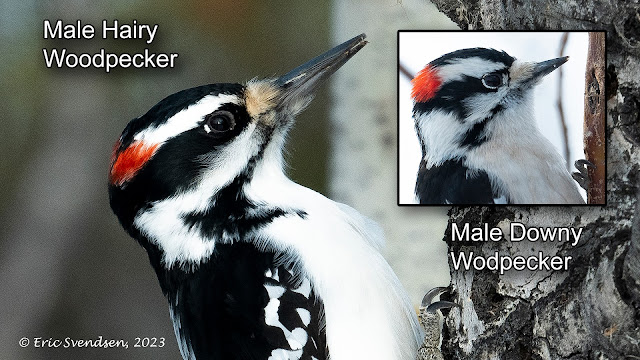Telling Downy and Hairy woodpeckers apart.
 |
| Hairy woodpecker (left) and downy woodpecker (right) compaired. |
I had the pleasure of hiking at Telford Lake near Leduc, Alberta yesterday. I spotted a small black and white bird with a conspicuous red mark on the back of its head flitting from branch to branch, examining each one carefully before moving off to the next one. I recognized it as a male downy woodpecker. The small size, mottled black and white back, and relatively small beak made the identification easy.
I had lost sight of it temporarily and thought I had found it again when I discovered this one was a female (below). Females do not have the conspicuous red patch on the back of their heads. I followed it for a short time when I lost track of it too. It was then that the oddest thing happened. A much larger version appeared at the base of a tree; it was, however, a male Hairy woodpecker. They are about twice the size of the downys and sport a much longer beak. The two species often get confused as they look similar from a distance. The key to separating them is to observe size and beak length.
 |
| Male downy woodpecker (left) and female (right). |
The downy woodpecker spent most of its time on smaller branches picking off bits of edible material from the wood's surface. The hairy woodpecker, on the other hand, spent its time on the trunk of trees and was audibly active in digging holes. I observed the hairy woodpecker extracting small grubs from its excavations. Their larger size and bill make them better suited for such activities. Although downys are capable of pecking holes, their diminutive nature makes the process less effective. The ones I saw seemed content exploring the branches instead of the main trunk of the tree.
Although the two species may look similar and possess woodpecker monikers, their ecological niches overlap very little. The downy uses its small size to glean food from smaller branches while the hairy excavated food from within substantially larger woody surfaces. It was a wonderful experience to see the three individuals all in the same area, within a few minutes of each other, each species busily foraging in its own unique way.
Thanks for reading.
Eric Svendsen. www.ericspix.com



Comments
Post a Comment